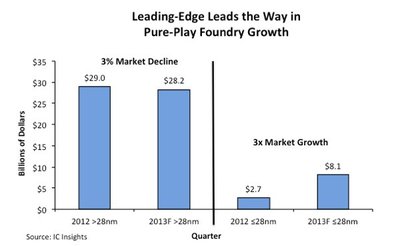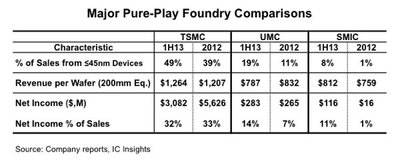Foundry sales growth to be driven by ≤28 nm devices
The pure-play foundry sales growth in 2013 is expected to be driven by ≤28 nm feature size device sales, according to research firm IC Insights.
Although forecast to represent 78% of total pure-play foundry sales this year, the >28 nm pure-play foundry market is expected to decline 3% in 2013. In contrast, the 2013 leading-edge ≤28 nm pure-play foundry market is forecast to triple this year.
Not only is essentially all the of pure-play foundry market growth forecast to come from leading-edge production, most of the profits that will be realised are also expected to come from the finer feature size sales.
TSMC had almost $1.5bn in 28 nm sales in 2Q13 and is forecast to have about $6.33bn in sales of 28 nm devices for all of 2013, over 3x the $2.10bn worth of 28 nm product the company sold in 2012. As a result, TSMC is expected to hold a 78% share of the pure-play foundry industry’s $8.10bn of ≤28 nm sales this year.

As shown in Figure 2, there has been a strong correlation between the percentage of sales a major foundry has for leading-edge IC devices and its net income percentage.

For 2013, 51% of TSMC’s revenue is expected to be from ≤45 nm processing. As expected, with GlobalFoundries’ fabs having a large portion of their capacity dedicated to producing AMD’s MPUs over the past few years, its processing technology is skewed towards leading-edge feature sizes. In 2013, 50% of GlobalFoundries’ sales are forecast to be from ≤45 nm production.
In 2012, only TSMC, GlobalFoundries and UMC had significant sales of ≤45 nm technology.
In 2013, TSMC is expected to have about 4x the dollar volume sales at ≤45 nm as compared to GlobalFoundries and about 12x the ≤45 nm sales of UMC ($10.33bn for TSMC, $2.53bn for GlobalFoundries and $0.89bn for UMC).
In contrast, SMIC only entered initial production of its 45 nm technology in early 2012, more than three years after TSMC first put its 45 nm process into production and is forecast to sell only $0.22bn of ≤45 nm technology this year. In fact, only 22% of UMC’s 2013 revenue and 11% of SMIC’s 2013 sales are forecast to come from devices having ≤45 nm feature sizes, which is why their revenue per wafer is so low as compared to TSMC and GlobalFoundries.
IC Insights continues to believe that the more profitable (ie, successful) major pure-play foundries, which include TSMC, GlobalFoundries, UMC and SMIC, will be those that keep at the leading edge of the process technology roadmap. This can be accomplished through joint ventures and licensing agreements (eg, the partnership between IBM and GlobalFoundries) and/or through significantly increasing research and development spending to develop advanced technology, as TSMC has done.
Electronex Sydney a major success
More than 1000 trade visitors and delegates have attended the Electronics Design & Assembly...
Gartner: Global AI chips revenue to grow 33% in 2024
Gartner has forecast that the revenue from AI semiconductors globally will total $71 billion in...
Electronex Expo returns to Sydney for 2024
Electronex — the Electronics Design and Assembly Expo will return to Sydney in 2024,...





